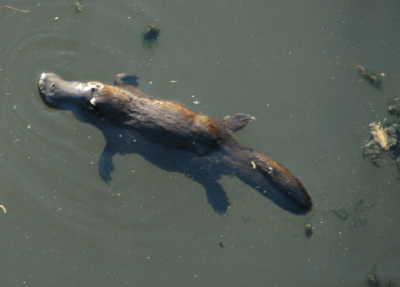
Platypus, also called duckbill, a small amphibious Australian mammal noted for its odd combination of primitive features and special adaptations, especially the flat, almost comical bill that early observers thought was that of a duck sewn onto the body of a mammal. Adding to its distinctive appearance are conspicuous white patches of fur under the eyes. The fur on the rest of the body is dark to light brown above, with lighter fur on the underside.
Platypuses range in length from 38 to 60 cm (15 to 24 inches); males are generally larger than females. Aquatic adaptations include the flat streamlined body, dorsally placed eyes and nostrils, and dense waterproof fur that keeps the platypus well insulated. Long guard hairs protect the soft underfur, which remains dry even after hours in the water. The extensive webbing on the front feet extends well past the claws and is essential in propelling the animal through the water. The paddlelike tail acts as a stabilizer during swimming, while the back feet act as rudders and brakes.
Odd skeletal features of platypuses include an archaic robust shoulder girdle and a short, wide humerus providing extensive muscle attachment areas for the exceptionally strong front limbs. The outside of the bill is covered by soft, sensitive skin. Inside the bill, adult platypuses do not have true teeth but instead have developed flat pads of hardened gum tissue. Male platypuses have a spur on the inner side of each ankle that is connected to a venom gland located over the thighs. The spurs can be wielded in defense, and the venom is potent enough to kill small animals and cause intense pain in humans if the spur penetrates the skin.
Credit : Britannica
Picture Credit : Google




